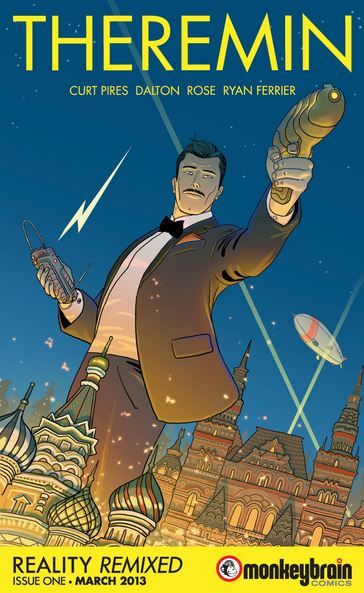My brain always shifts toward musical thoughts whenever possible. So when I learned Curt Pires was writing a story called Theremin, I assumed he meant the musical instrument. As I found out quite quickly in this interview, Pires' new collaboration with artist Dalton Rose is focused on the inventor of the instrument, Léon Theremin. The series is slated to launch digitally from Monkeybrain Comics in March.
Robot 6: When we last spoke in September, you said your game plan for Theremin was that you intended to self-distribute it. How did it land at Monkeybrain?
Curt Pires: Initially my game plan was to self-distribute Theremin, correct. Well, It really developed out of talking with Dalton, discussing our plans for the book. We decided that we should sample the book to potential publishers, at least put feelers out there – see what the interest was in the book. We sent the first six pages and plot info over to Chris Roberson and Allison Baker at Monkeybrain, and they liked what they saw enough to invite us aboard to tell our story there. We could not be happier to be telling this story with them.
The theremin is a relatively unique musical instrument. What prompted you to develop a series call Theremin?
The story is less about the instrument and more about the man behind the instrument. Leon Theremin is a man whose history, besides being steeped in scientific innovation, is steeped in intrigue and an almost inexplicable series of events.
Rewinding a bit: It’s late 2011/ early 2012. A friend of mine Richard Ballermann ( he colored the first three issues of Prophet ) has been helping me out with some pre-press work on an earlier project of mine, and running some color tests for the same project. He mentions he has to design a magazine for his final project in his graphic design major. He needs writing for the magazine; he asks me if I’d like to be involved. The theme of the magazine is noise/ambience. He asks me to write an article about Leon Theremin. He sends over research links. I read, I observe, I immerse myself and I am blown away. As soon as I read up on the history, Ideas begin exploding in my head. The story is birthed.
It’s a story of human history, invention, frequencies that change existence, and temporal espionage.
Can you discuss the collaborative dynamics between you and artist Dalton Rose?
Dalton is a very talented individual. The dynamics are very different from on LP. They’re very different projects though so that seems to make sense. My writing on Theremin, and Theremin in general, is a much denser, concentrated, approach to storytelling and panel density. Dalton manages to command the grid, work under these conditions quiet brilliantly. For the more experimental pages nothing is sacred. I script the pages, but Dalton ultimately has carte blanche on laying them out, delivering on the ideas, translating them.
Dalton is doing some really interesting and beautiful stuff on this book. He’s coloring himself on it, and its definitely different from what you’re seeing in Sacrifice. He colors in a way few people do. Everything has a beautiful glow to it. It’s very painterly. My words can’t really do justice to it.
In this June tweet, you discussed the Theremin solo in Beach Boys' I Just Wasn't Made for These Times. How much did music influence the narrative of the story?
The narrative of the story exists independent of music, but I find the two often have an ouroboros-like effect on one and other, if that makes sense? I find they feed on each other in a very cyclical manner. I was gazing over the first issues script and listening to my ipod on shuffle and that The Crystals/Spector jam Da Doo Ron Ron popped on, and I realized that, man, this first issue is that first ten seconds of that song if you looped it . Beautiful noise. So yeah, it’s a constant give and pull between the two mediums. I feel like everything connects at some point.
Are you editing your own work, or is someone from Monkeybrain helping to edit the project?
I am editing my own work on this one. I am naturally a very critical and vicious person when it comes to my personal work, so this has been very, very, easy. Nothing is sacred, and no bullshit is entertained.
Is the pacing different for a story when written for digital?
I think pacing is different definitely. I’m a big believer in the 99 cent price point. So we're going for that. So my challenge to myself, to team Theremin, is for us to fit the utmost story in these chunks as we can, in a satisfying and not arduous manner. I’m looking at back when Image was putting out the 16-page comics like Fell and Casanova, as my guide point. Well constructed content bombs. I’m breaking the story down and pacing it to work as such. I think it makes it stronger actually. Each story is 12-15 pages in length, with five-plus pages of back matter.
What prompted you to explore the spy genre with this project?
Without giving away too much of the story, Leon Theremin's story is very much one of espionage, of the role of the spy, and the line between this world and the world of the spy. The spy genre is one that has always blurred the line between fiction and reality, and this is very much what Theremin is about. This story gives me a chance to crack the genre open, question it, rebuild the parts of it I find to be decrepit, and re-assemble it into what I wish it to be.


